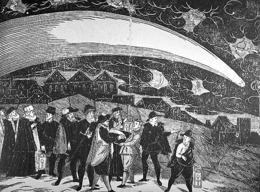 | ||
Similar Great Comet of 1744, Great Comet of 1882, C/1861 J1, Great Comet of 1811, Comet Humason | ||
The Great Comet of 1577 (official designation: C/1577 V1) was a comet that passed close to Earth during the year 1577 AD. It was viewed by people all over Europe, including the famous Danish astronomer Tycho Brahe and Turkish astronomer Taqi ad-Din. From his observations of the comet, Brahe was able to discover that comets and similar objects travel above the Earth's atmosphere. The best fit using JPL Horizons suggests that the comet is currently about 320 AU from the Sun (based on 24 of Brahe's observations spanning 74 days from 13 November 1577 to 26 January 1578).
Contents
Observations by Brahe and others
Tycho Brahe, who is said to have first viewed the comet slightly before sunset on November 13 after having returned from a day of fishing, was the most distinguished observer and documenter of the comet's passing.
Sketches found in one of Brahe's notebooks seem to indicate that the comet may have travelled close to Venus. These sketches depict the Earth at the centre of the Solar System, with the Sun and moon in orbit and the other planets revolving around the Sun, a model that was later displaced by heliocentricity. Brahe made thousands of very precise measurements of the comet's path, and these findings contributed to Johannes Kepler's theorising of the laws of planetary motion and realisation that the planets moved in elliptical orbits. Kepler, who was Brahe's assistant during his time in Prague, believed that the comet's behavior and existence was proof enough to displace the theory of celestial spheres, although this view turned out to be overly optimistic about the pace of change.
Brahe's discovery that the comet's coma faced away from the Sun was also significant.
One failing Brahe had in his measurements was in exactly how far out of the atmosphere the comet was, and he was unable to supply meaningful and correct figures for this distance; however, he was, at least, successful in proving that the comet was beyond the orbit of the Moon about the Earth, and, further to this, was probably near three times further away. He did this by comparing the position of the comet in the night sky where he observed it (the island Hven, near Copenhagen) with the position observed by Thadaeus Hagecius (Tadeáš Hájek) in Prague at the same time, giving deliberate consideration to the movement of the Moon. It was discovered that, while the comet was in approximately the same place for both of them, the Moon was not, and this meant that the comet was much further out.
Brahe's finding that comets were heavenly objects, while widely accepted, was the cause of a great deal of debate up until and during the seventeenth century, with many theories circulating within the astronomical community. Galileo claimed that comets were optical phenomena, and that this made their parallaxes impossible to measure. However, his hypothesis was not accepted.
Five other observers of the comet — Taqi al-Din Muhammad ibn Ma'ruf, Helisaeus Roeslin, William IV, Landgrave of Hesse-Kassel, Cornelius Gemma, and Michael Mästlin — also identified it as superlunary. The most complex of the early representations of the Great Comet, described as "an interesting, though crude, attempt", may have been that of Roeslin.
In art and literature
The literature resulting from the passing of the comet was prolific, and these works, as well as the ideas presented by many astronomers, caused much controversy. However, the idea that comets were heavenly objects became a respected theory, and many took this concept to be true. Artwork inspired by the event was also made—artist Jiri Daschitzky made an engraving that was inspired by the passing of the comet over Prague on November 12, 1577. Cornelis Ketel painted the portrait of Richard Goodricke around 1578. Goodricke had reached adulthood in 1577 and apparently saw the comet as an omen and had it included in the painting.
